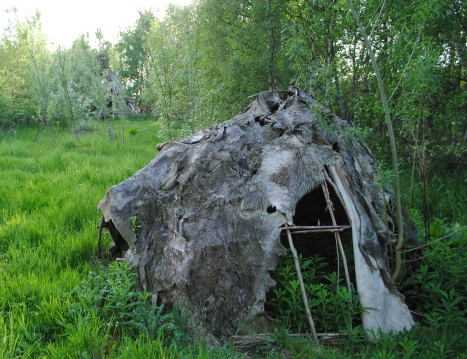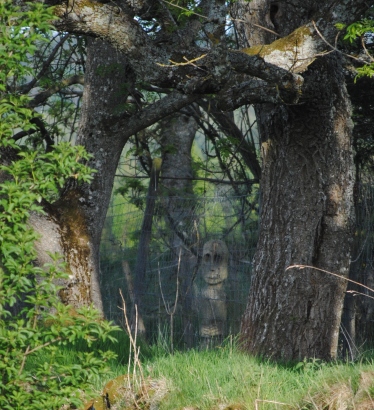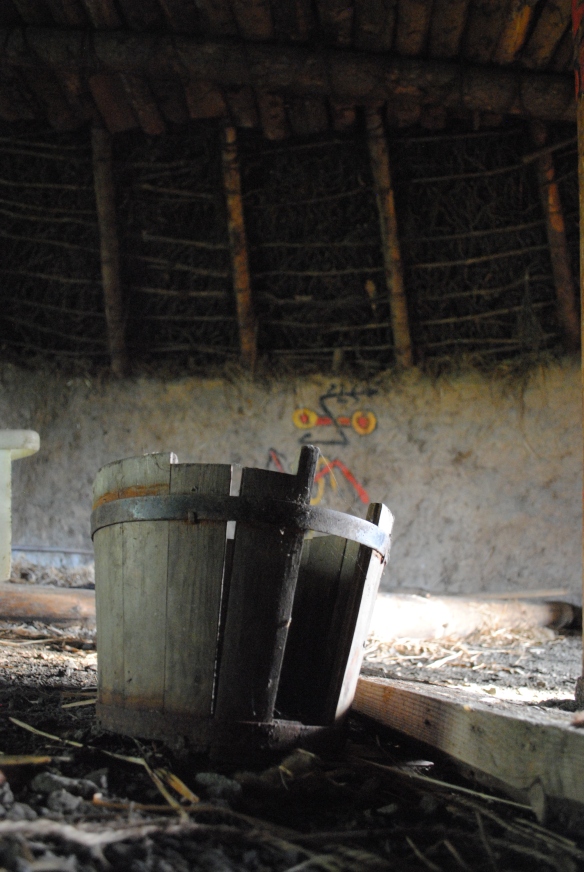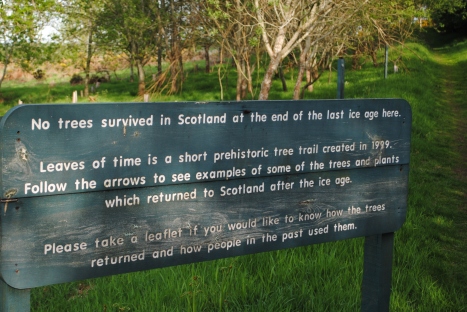Three times I have been to this place, I should have been more…
The first time was in 1994 to take part in excavations on the site before the Archaeolink Prehistory Park was built. The second time, a few years later, was during a research visit to study the recumbent stone circles of Aberdeenshire.
I could barely walk and had to go to casualty in Insch to get my leg seen to: a trapped nerve from sleeping on the hard ground without a camping mat….! So I hobbled amongst the structures…strong pain killers and looking at too many stone circles leave my memories hazy…but it was clearly a vibrant place, where reconstructions of prehistoric structures were used to bring pasts alive.
The third time I visited was a few weeks ago. I had heard that the centre had closed over a year ago but was surprised by what I encountered.
 At the heart of the Archaeolink Prehistory Park was the award winning visitors centre by Edward Cullinan Architects. The clean lines of the green mound evoked prehistoric mounds and barrows (but has a subsequent Teletubbi-esque cultural reference): now a thatch of gorse, elder and willow, begins to reclaim it for the woods.
At the heart of the Archaeolink Prehistory Park was the award winning visitors centre by Edward Cullinan Architects. The clean lines of the green mound evoked prehistoric mounds and barrows (but has a subsequent Teletubbi-esque cultural reference): now a thatch of gorse, elder and willow, begins to reclaim it for the woods.

 Like many heritage centers, it had been designed to take you on a journey through space and time ! From the reconstructions of structures which may have been occupied by the earliest settlers in Aberdeenshire.
Like many heritage centers, it had been designed to take you on a journey through space and time ! From the reconstructions of structures which may have been occupied by the earliest settlers in Aberdeenshire.
 Through examples of Neolithic and Bronze Age ceremonial structures which are found across the north east of Scotland.
Through examples of Neolithic and Bronze Age ceremonial structures which are found across the north east of Scotland.
 Through an Iron Age shrine and settlement.
Through an Iron Age shrine and settlement.
 The empty eyes of a wooden Ballachulish style figurine, adjacent to a clootie well.
The empty eyes of a wooden Ballachulish style figurine, adjacent to a clootie well.
 Who still stands sentinel over the abandoned round house.
Who still stands sentinel over the abandoned round house.
Helpless, the house now slowly decays, doors open to the elements.
 Until recently, this reconstruction of an Iron Age round house, was a place for people to learn, and celebrate the rich heritage of north east Scotland. The ash of the last fire, the faint echo of voices, is slowly disappearing.
Until recently, this reconstruction of an Iron Age round house, was a place for people to learn, and celebrate the rich heritage of north east Scotland. The ash of the last fire, the faint echo of voices, is slowly disappearing.
 Fragments of material culture, broken reconstructions of pots, clay loom weights, wooden artefacts, are slowly becoming archaeology within the interior: this time we can witness the end of a prehistory.
Fragments of material culture, broken reconstructions of pots, clay loom weights, wooden artefacts, are slowly becoming archaeology within the interior: this time we can witness the end of a prehistory.
 I encountered the slightly surreal patchwork of abandonment fragments of a recreated past. Tinged with a melancholy for the end of the hopes of a future to be informed and sustained through reference to fundamentally important elements of the archaeology, history and heritage of north east Scotland. I hope this is not The End of Prehistory.
I encountered the slightly surreal patchwork of abandonment fragments of a recreated past. Tinged with a melancholy for the end of the hopes of a future to be informed and sustained through reference to fundamentally important elements of the archaeology, history and heritage of north east Scotland. I hope this is not The End of Prehistory.
It is clear that the site has a latent energy and verdant potency from established woodlands, matured landscaping, and the invasive weeds following (temporary ?) abandonment.
 Perhaps, we will be left with a modern ruin, to add to a contemporary archaeology of heritage centers and museums. Or perhaps there is an opportunity, to learn from the recent past, and to reinvent and revitalise.
Perhaps, we will be left with a modern ruin, to add to a contemporary archaeology of heritage centers and museums. Or perhaps there is an opportunity, to learn from the recent past, and to reinvent and revitalise.
Perhaps, there has never been The End of Prehistory.





Excellent photos.
When cutbacks bite, I guess there will be many more examples of abandoned ‘heritage sites’ – and I guess there might well be a ‘geography’ and a ‘politics’ to this as well: what sort of sites are more likely to be abandoned?; which periods of time will be trendy enough to maintain? Television ‘block-busters’ this summer suggest that ‘medieval’ sites might be quite well supported for some time – to go alongside the Edwardian stately home and the inevitable rise of the First World War!
Hi Geographies of Heritage Thanks for your comment, yes there is a cycle to fashionable periods, it perhaps fleetingly touches on the prehistoric. G
Pingback: The geography and periodisation of heritage | Geographies of Heritage
Hi Geographies of Heritage Thanks for your positive reference to the blog. G
Beautifully written with evocative imagery – thank you for sharing this post and giving us food for thought.
Hi Beautifuldystopias Thanks for your comment, I am glad you liked the post. G
I went once, in the mid-nineties when I was digging in Angus, but much as I wanted to like the idea of a whole heritage park about prehistory a lot of the interpretation seemed dated and unreflective. I was a stroppy post-grad in those days and no doubt hyper-critical but the whole thing seemed a bit of a missed opportunity. There is a serious oversupply of uncritically presented ‘iron age’ roundhouses up and down Britain, which probably didn’t help Archaeolink’s cause.
Hi Shelteringmemory Thanks for comments. Yes its amazing how many round house reconstructions there have been, they certainly seem to capture to the imagination in some way : perhaps they are just easier to construct than a timber longhouse? G
It must be something like that. There are three at the WWT reserve at Martin Mere in Lancashire (not sure how/why a wildfowl reserve got roundhouse reconstructions) which, when I went last month, were populated by a tribe of Viking re-enactors. Perhaps you can download the plans for one from the Butser website or something.
What a curious site – unlike so many heavily documented abandoned sites (fairgrounds and that ilk) a place reclaimed about a place reclaimed, as perhaps a somewhat poignant message about the human nostalgia..?
Hi Katiejand Thanks for your comment. Yes, nostalgia and place are probably inextricably linked in many cases. G